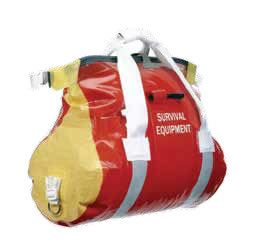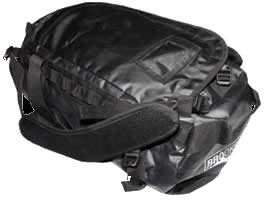
Like flares and life jackets, abandon-ship bags are purchased and outfitted with the hope theyll never be needed. Designed to store and protect emergency supplies-and to keep them readily available-ditch bags allow sailors to supplement the often paltry supplies stored in life rafts.
The last ditch bags we reviewed were the ACR RapidDitch and RapidDitch Express (PS, October 2006), and our last full-blown test appeared in the March 2001 issue. This year, we checked out the Survival Equipment bag made by North Carolina-based WaterShed Inc. Unlike the ACR bags, which use internal closed-cell foam for buoyancy and are not waterproof, the Watershed duffel is a dry bag that uses air to provide buoyancy and keep contents dry.
The Survival Equipment bag comes in two sizes, the 1,800 cubic-inch/30-liter model ($140) we inspected and a larger 2,800 cubic-inch/46-liter version ($160). Both bags are constructed of high-visibility, bright red and yellow, polyurethane-coated nylon and feature overlapping, radio frequency (RF)-welded seams. Other construction details include Mil-spec stitching; dual, two-inch-wide strips of SOLAS reflective tape; two stainless-steel D-rings; compression straps; and a Mil-spec, screw-top oral inflation valve that allows users to inflate the bag after its sealed. The duffel straps are extra long, which makes it easy to slip your arms through them and hold the bag to your chest when added personal flotation is needed.
Testers found the quality of construction for the Survival Equipment bag to be excellent. The rubber ZipDry waterproof seal, which opens and closes like a giant freezer bag, kept the bag watertight during tests and was easy to operate, even with gloved hands. The length-wise opening also provides easy access to all contents-unlike most dry bags, which have openings at one end and deep storage compartments.
While the open space of the bag is acceptable from a storage perspective, wed like to see some way to organize the contents. Watershed offers custom-fit, nylon duffel liners/organizers for some of its other bags. Such a liner-comprising integral equipment lanyards and internal pockets-would be a worthwhile addition to the survival bags. In lieu of this option, we recommend organizing your emergency gear in smaller bags and then storing those inside the Watershed duffel. We also suggest float-testing the bag once youve loaded it with your survival gear, before storing it on board.
Bottom line: For the price, wed like to see interior storage pockets included, but the bag would make a great stand-alone or supplemental ditch bag, particularly for items that must remain dry. It gets a big thumbs up.

Brooks-Range duffel
The first time testers saw the Brooks-Range water-repellent duffel bag, we knew it was a high-quality, well-made product. It features double-stitched seams, a heavy-duty zipper protected by a flap, sturdy carrying straps on each end made of inch-wide webbing, and compression straps on the sides. Carabiner-ready loops flank the top-loading, U-shaped zippered opening, and a zippered interior mesh compartment holds small items. The bag can be carried as a duffel, using the webbing handles, or worn as a backpack, using the two padded straps with adjustable buckles.
The Chinese-made, polyester duffel is advertised as only water-resistant-not waterproof-but when testers drenched it with a garden hose, the interior stayed bone dry.
The bags backpack straps passed our load test with flying colors, and the polyester laminate exterior proved to be durable and abrasion-resistant. We loaded the bag with about 50 pounds of rocks and hung it overnight from a tree branch; not a seam ripped. Testers then dragged the duffel along an asphalt driveway, took it on numerous trips in the mountains and at sea, and inadvertently left it outdoors in a blizzard. It remained unfaded and chafe-free.
We tested the bags smallest version (2,560 cubic inches; 12 x 12 x 20 inches; 3 pounds empty), which costs $92. It is large enough to hold a weekends worth of clothes, foul-weather gear, and sailing essentials. Brooks-Range offers the duffel in two larger sizes ($117-$123) and a no-hassle guarantee on all of its products.
Bottom line: The Brooks-Range is a great choice for sailors who want to protect their gear from the elements during dinghy rides, air travel, and shoreside excursions. Its a particularly good match for weekend cruisers, delivery crew who hop from boat to boat, and offshore racing crew who need a lightweight, water-resistant bag to haul their gear in.

































